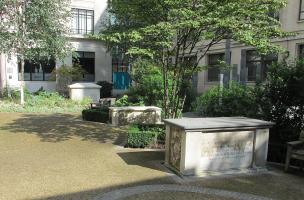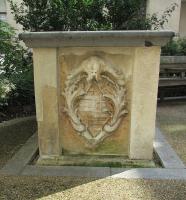 Churchyard of St Gabriel Fenchurch Street.
Churchyard of St Gabriel Fenchurch Street.
 Churchyard of St Gabriel Fenchurch Street.
Churchyard of St Gabriel Fenchurch Street.
Along Fenchurch Street in the City of London is a curiosity: the tiny preserved churchyard of St Gabriel Fenchurch Street, up a lane on the north side of the street called Fen Lane. There is not much there now, no sign of the Pre-Fire Church, but just a handful of chest-tombs of much later date, three in a row. The best of these is that to Anne Cottesworth, d.1762, which has on eth end a carved shield of arms in lozenge form within a surround of leaves and scrolls. A stone plaque notes that the Parish was united with St Margaret Pattens in 1670, and St Edmund the King, Lombard Street in 1954 – the tombs thus relate to St Margaret Pattens. It is also noted that the churchyard was paved and planted by some of the owners and occupiers of the adjoining buildings in 1960. A pleasant little green space.
Anne Cottesworth, d.1762, heraldic arms.
Strype, the historian who followed and enlarged the work of John Stow, describes St Gabriel Fenchurch thus:
“In the midst of this Street standeth a small Parish Church, called S. Gabriel Fenchurch, corruptly Fanchurch.This Church was enlarged in Length nine Feet, richly and very worthily beautified at the proper Cost and Charges of the Parish, in the Years of our Lord God 1631, and 1632.
Churchwardens: Thomas Colt, George Godscal,
The Cost of it arising to 537l. 7s. 10.
A very fair Figure of the King's Arms in Glass in the Chancel Window, was the Free Gift of Thomas Clark of this Parish, Glazier...
Helming Legget, Esq; by License of Edward the third, in the 49. of his Reign, gave one Tenement, with a Curtelage thereto belonging, and a Garden with the Entry thereto leading, unto Sir John Hariot, Parson of Fen Church, and to his Successors for ever; the House to be a Parsonage House, the Garden to be a Church Yard, or Burying Place for the Parish.’
It would seem to be part of that garden of Helming Legget which survives as the little Churchyard today. As Strype notes, St Gabriel stood in the centre of the road between Rood Lane and Mincing Lane, and 18th Century sources say that carriages had to pass to the south side, and only pedestrians could go on the north side. Rather meanly, Strype ends his short description with the acid comment ‘This Church being burnt down by the Fire, was built no more, whereby the Street is the fairer.’
Various authorities note that the Church was until the 16th Century known as St Mary Fenchurch, and it has been surmised that the full dedication was to St Mary, All Saints and St Gabriel. What did it look like? We cannot say, but an article in the European Magazine surmises that ‘it appears to have been of the period immediately subsequent to the Conquest – a period that [is] noted as peculiarly favourable both to ecclesiastical and military architecture. So we can presume a little Norman church, perhaps little changed in its exterior except for that 9ft lengthening a generation before it was burnt in the Great Fire.
A little along Fenchurch Street, just to the south down Mark Lane and less than a hundred yards away from St Gabriel’s Churchyard, is the pre-Fire tower from All Hallows Staining, a little thing of the early 14th Century, so seemingly rather later than St Gabriel’s, but another miniature evocation of pre-Fire London – see this page.
North to St Andrew Undershaft // or to Cornhill // West along Fenchurch Street to St Mary Woolnoth // South to St Olave Hart Street
Another site of a lost pre-Fire Church – St Olave Silver Street
Churches in the City of London // Introduction to church monuments
Visits to this page from 8 May 2016: 5,281